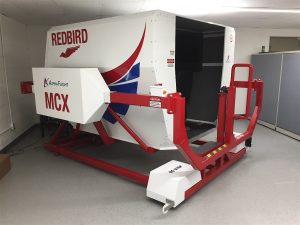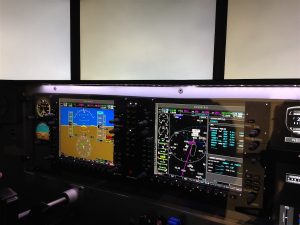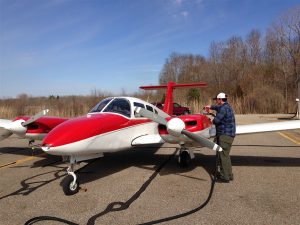Initial Commercial Multi Engine Course
Get Your Multi Engine Initial Commercial Certificate in 6 Days
For Whom is the Initial Commercial Multi Engine Course?
- Initial Commercial Pilot Certificate: This course is specifically for candidates with a private pilot certificate (airplane single engine land), who wish to obtain their commercial pilot certificate directly in a multi engine airplane, without doing it in a single engine airplane first.
- Commercial Category Transition: This course can also be used by commercial pilots transitioning from a different category of aircraft (e.g. helicopter) to airplanes. They will, however, need to supplement it with additional cross-country time in either single- or multi-engine airplanes.
Because the above candidates do not merely add an additional class rating to their commercial pilot certificate, they need to meet all the aeronautical experience requirements in 14 CFR 61.129(b).
Note: If you already hold a commercial pilot certificate with an airplane rating, this course does not apply to you. Please see our Accelerated Add-On and Regular Add-On Courses instead. We also offer a Commercial Multi Engine Add-On / MEI Combination Course.
Training Times Included
- Course Duration:
5 days of training, plus one day for FAA Practical Test (typically with an additional day as potential weather backup for the test, at the examiner’s discretion). - Flight Training:
20 hours of multi engine flight instruction in a Piper PA-34-200 Seneca, equipped with an Aspen PFD and a Garmin GTN 650 GPS. - FAA Practical Test:
Airplane rental for the practical test is included in the course price (for up to two hours).
The examiner fee of $700 is not included and payable directly to the examiner on the day of the practical test. - Ground Instruction:
Unlimited ground instruction (review of multiengine and commercial pilot theory, oral exam preparation) is included on the above 5 course days. - Advanced Aviation Training Device (AATD, “flight simulator”):
Access to the Redbird MCX AATD (for instrument approach and multiengine procedure practice) is extra on the above five training days.
Note: Up to 25 hours of the Redbird MCX AATD time can be applied towards the 1500 hours required for the Airline Transport Pilot (ATP) certificate.
Course Cost
Course Cost: $9999
Includes everything in the list on the left.Additional Flight Training Time:
If additional flight training is becomes necessary beyond the hours listed on the left, the price is $350/hour for the Piper PA-34-200 Seneca and $60/hour for flight instruction.- Additional Ground Instruction:
Ground instruction during the 5 days of the original initial commercial multi engine course is unlimited. If ground instruction is needed on additional days, it is billed at $60/hour, or $300/half day, or $600/day. Free access to the Redbird MCX AATD is extra for up to two additional days during this time.
Flight Training (14 CFR 61.129(b)(3))
10 hours of flight training (dual instruction received) in a complex multiengine airplane (14 CFR 61.129(b)(3)(ii)), which include:
Instrument Training: 5 hours in a multiengine airplane (14 CFR 61.129(b)(3)(i)). (Assuming an additional 5 hours have already been obtained in a different category or class of aircraft, e.g. during a single-engine instrument rating – contact us for the regulatory details.)
Cross-Country Training:
One daytime and one nighttime dual cross-country flight of more than 100 nm straight-line distance from the original point of departure (14 CFR 61.129(b)(3)(iii) and14 CFR 61.129(b)(3)(iv)).
The above cross-country training can be IFR and combined with the above instrument training (see legal interpretation Sun (2011)). This will leave 5 hours of dual instruction for FAA practical test preparation.
Solo or with an Authorized Instructor (14 CFR 61.129(b)(4))
10 hours in a multiengine airplane performing the duties of pilot in command, including:
- 5 hours of night VFR, including 10 takeoffs and landings at an airport with an operating control tower (14 CFR 61.129(b)(4)(ii)).
- “long commercial cross-country flight” (300 nm total distance with landings at 3 points and one landing at a straight-line distance of at least 250 nm from the original departure point) (14 CFR 61.129(b)(4)(i)).
We combine the above two requirements into one flight to leave the remaining 5 hours for daytime self-practice for the FAA practical test. The instructor will always accompany you during the course, but for these 10 hours the instructor’s presence does not constitute flight training (see legal interpretation Kuhn (2014)).
Training Time Table
The training schedule for this initial commercial multi engine course is designed to achieve best efficiency. First we give you the basic minimum training to be able to perform the duties of pilot in command of the aircraft, so you can operate it without instructor assistance. Then you will fly all the legal cross-country and instrument training requirements for the commercial rating. This will allow you to get more familiar with the airplane and make its operation more intuitive. Finally, we will focus on training you to fly maneuvers, approaches, and landings to ACS standards for the FAA practical test.
An advanced aviation training device (AATD) is available to prepare you for the individual stages and to reinforce training in any areas that need more work, without incurring extra flight time.
This approach works very efficiently for candidates for whom cross-country flying per se poses not difficulties (either due to innate ability or previous experience). If you still struggle with cross-country flight and navigation and have to focus heavily on these concepts, we will need to adjust the schedule, as you would be overwhelmed by trying to improve your cross-country skills while flying an unfamiliar aircraft.
Day 1
- Morning:
3 hours of Redbird MCX AATD. Verification that you know all the maneuver procedures (and an opportunity to tie up loose ends); rehearsal of emergency procedures. Cross-country procedure instruction to commercial level. - Afternoon:
1.5-hour upper airwork flight and landing practice, cross-country navigation. Airplane familiarization with goal to operate aircraft independently as PIC without instructor assistance. Dual instruction to commercial level. Evening:
5 hours of night VFR and long commercial cross-country flight, including 10 landings at an airport with an operating control tower, performing the duties of pilot in command with an authorized instructor on board. (If the student is not proficient in the aircraft yet, this flight can be moved to another evening.)
Day 2
Morning:
Rest period and ground instruction. Redbird MCX AATD as needed to solidify procedures and instrument proficiency. 1-hour practice flight (upper airwork and landings), performing duties of pilot in command.Afternoon:
2-hour daytime dual cross-country. Instruction to commercial level. Conducted IFR under simulated or actual instrument conditions.Evening:
2-hour nighttime dual cross-country. Instruction to commercial level. Conducted IFR under simulated or actual instrument conditions.
Day 3
- Morning:
1.5-hour upper airwork flight with instrument approach and 3 landings. Dual instruction to commercial level. - Afternoon:
1.5-hour upper airwork flight and landing practice, performing duties of pilot in command. Evening:
Ground instruction (review of multiengine theory) or Redbird MCX (instrument approach or multiengine procedure practice), as needed.
Day 4
Morning:
1.5-hour upper airwork flight with instrument approach and 3 landings. Dual instruction to commercial level.Afternoon:
1.5-hour upper airwork flight and landing practice, performing the duties of pilot in command.Evening:
Ground instruction or Redbird MCX.
Day 5
Morning:
1.5-hour upper airwork flight with instrument approach and 3 landings. Dual instruction to commercial level.Afternoon:
1 hour flight: landing practice (or 2 instrument approaches, whichever needs more work), performing duties of pilot in command.Evening:
Ground instruction (final checkride preparation).
Day 6
- Morning or afternoon:
FAA Practical Test (typically at C65, but an alternate location may be chosen based on weather).
Weather Issues
Some of the training can be conducted IFR (e.g. the 2-hour dual cross-country flights) or VFR on top, as many of the training flights end in an instrument approach anyway. If the weather is not conducive to flight at all on one of the days, the flying will be compressed into four days, and the bad weather day will be used for ground instruction and procedure and instrument practice in the Redbird MCX AATD. If the weather prevents flying on two training days, the practical test will have to be postponed. To safeguard against this, you may elect to arrive for your course one or two days early if the weather forecast is questionable. If the weather is bad on the practical test date, the examiner often has a weather backup date the next day (while we try to arrange this, ultimately but this is up to the examiner though).
Candidate Preparation and Proficiency
This is an accelerated course, and you need to come well prepared. Doing the initial commercial multi engine course will lead to some intense back-to-back training days including some night flying, which will leave little time for evening study. How well you need to prepare, before arriving at our facility, is outlined below. There are three components of preparedness:
Theoretical Knowledge
This course is very achievable for the price advertised. The instructor has gone through a course like this himself originally. But you must prepare at home ahead of time with the training materials which we will send you in advance. You will receive two 1-hour video conferences to help you with this.
During the course we will review all the ground school materials twice: The first time the instructor will remind you of the content and explain anything that may have been unclear during your home study (you must understand after this one explanation). The second time you will present the material to the instructor in a mock oral setting. There will be no time to go through everything twice a day because either you do not understand or do not remember. Furthermore, ideally we would like to take you beyond just the necessary basics for the practical test, so the better prepared you come, the more additional information we can impart on you, which is really one of our training objectives.
Airmanship
You must also be very proficient at airplane flying in general, as there will be no time to get you “back into it”. If you have not flown in the last three months, either get some practice before the course or take our Compressed Course (and expect more flight time). Having some prior flight experience in a single-engine complex airplane is an asset.
On your first flight you will be asked to go through all the practical test maneuvers one by one, and you must already know all the procedures for them and execute them without being prompted for the individual steps. The flights are intended to give you practice to execute the maneuvers within ACS standards (in terms of altitude, heading, bank angle, and airspeed tolerance), not to teach you how to perform the maneuvers in principle. Each maneuver will be flown once on each flight, with the option of practicing a few of the weaker maneuvers a second time if needed; after that, we must move on to the next maneuver (you will get a chance to practice each maneuver on the next flight again).
Instrument Flight
You must be proficient at instrument flight, because you will be required to fly a one-engine-inoperative instrument approach on your practical test. Whether you are formally current and/or had a recent IPC is immaterial; some people successfully prepare with the flight simulator on their home computer. All you need is to be proficient at instrument approaches – IFR clearances and departure/en route procedures are not required.
Each of your upper airwork training flights will end in an instrument approach. While we can do a couple of hours of simulator work to get you used to the avionics layout, in the airplane you will get to fly 4 instrument approaches during the course: generally two LPV (GPS) precision approaches and two VOR approaches (though we recommend you nail the VOR the first time and get yourself a third LPV instead). A fifth instrument approach may be doable if you are good at landings and want to do one instead of the landing practice flight. Any more practice will require extra flight time.
Summary
Unless you have studied all the training materials diligently beforehand and come exquisitely prepared, you will need more flight time (and more ground instruction as well). We do not promise you will finish in the time advertised; we merely provide you with an environment where you can, if you apply yourself, as other candidates have done before you, and we make it our personal goal to assist you as much as possible.
On the other hand, this commercial initial course gives you 20 hours of flight time in the Piper PA-44-180 Seminole, which will make you much more familiar with the aircraft than candidates taking our 7-hour accelerated add-on course, and those candidates make it, too. So the flight time in this course is generously measured (and at the same time the legal multiengine minimum), and you should have no difficulty completing it in the time advertised if you have reasonable capability.




